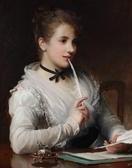


Charles Joshua Chaplin nacque l'8 giugno dell'anno 1825 nel Les Andelys, Eure, Francia, da madre francese, Olympia Adelle Moisy, e da padre inglese - John Chaplin era un rigattiere d'oggetti d'arte che provenivano dall'Inghilterra; dopo aver studiato presso l'Ecole des Beaux-Arts di Parigi dal 1840, e aver preso lezioni private nello studio di Michel Martin Drolling, nel 1845 espose il 'Ritratto della madre dell'artista' al Salon de Paris, la mostra d'arte ufficiale della Académie des Beaux-Arts, presentandosi sia come ritrattista che come paesaggista e, grazie al successo che da allora riscosse, qualificandosi così come uno dei pochi artisti che godettero di successo ancora in vita.
nato come pittore dei paesaggi della campagna circostante Auvergne, una contea situata nel cuore della Francia, si dilettò in giovane età anche nel ritrarre composizioni floreali anche se il suo stile può decisamente essere inquadrato nel movimento artistico del Realismo che nella Francia tardo ottocentesca prese il sopravvento sul Romanticismo in cui era invece coinvolto l'intero vecchio continente.
A poco a poco alle tonalità del fango utilizzate da Chaplin si sostituiscono le sfumature del rosa, del grigio e del bianco, che diedero ai suoi modelli una opalescente carnagione madre-perlata; dopo aver dipinto ritratti ed aver sperimentato le sue abilità nell'ambito della pittura ornamentale, Chaplin comprese, a partire dal 1850 circa, che i suoi soggetti preferiti erano quelli che incarnavano la grazia femminile vista nei momenti di vita quotidiana di una giovane donna, ritratta in differenti pose, dal canto,

al riposo,




alla lettura,





al momento del rigoverno della casa


come se catturata casualmente,


con leggerezza e noncuranza, ponendo l'accento sugli elementi decorativi del dipinto.
I suoi ritratti di donne e ragazze, spesso in pose sensuali e collocate in ambienti sfumati, adorne di abiti trasparenti,

attirarono l'attenzione dell'alta società e dell'aristocrazia parigina durante la Terza Repubblica francese (1870-1940) facendosi garanzia di successo e di agio, tanto che fu uno dei pittori più popolari del suo tempo.
L'Imperatrice Eugenia,
 Empress Eugénie by Disderi
Empress Eugénie by Disderimoglie di Napoleone III e grande ammiratrice dello "stile Pompadour", rapidamente cadde sotto l'incanto dello stile neo-rococò di Chaplin che divenne a far presto parte degli artisti preferiti a corte. Nel 1859, quando il suo ritratto di Aurora venne bandito dai giudici del Salon definito "troppo eroticamente allusivo", Napoleone III accorse in sua difesa e fece rimettere in gara il dipinto. In tarda età Chaplin venne anche valutato per la decorazione d'interni, tanto che ricevette l'incarico di ripristinare gli interni delle camere dell'Imperatrice.
Tra le altre opere che gli furono commissionate vanno citate la pittura delle porte e dei numerosi pannelli vetrati che le sovrastavano nel Salon des Fleurs al Palais de le Tuileries, oggi purtroppo non più esistente, poiché distrutto da un incendio nel 1871 venne velocemente demolito, e la decorazione al Salon de l'Hémicycle del Palais de l'Elysée.
Ammirato al suo tempo anche da personaggi celebri quali Émile Zola, Théophile Gautier ed Édouard Manet, oggi i suoi dipinti sono sparsi tra collezioni private e grandi pinacoteche un po' in tutto il mondo, dalla Francia, al museo dell'Hermitage a San Pietroburgo agli Stati Uniti, alla Gran Bretagna.
A presto ♥



- picture 1
- picture 2
- picture 3
Charles Joshua Chaplin was born on June 8th, 1825 in Les Andelys, Eure, France, from a French mother, Olympia Adelle Moisy, and an English father - John Chaplin was a broker of art objects coming from England; after studying at the Ecole des Beaux-Arts in Paris from 1840, and taking private lessons in the study of Michel Martin Drolling, in 1845 he exhibited the 'Portrait of the Artist's Mother' at the Salon de Paris, the official exhibition of the Académie des Beaux-Arts, introducing himself both as a portrait and a landscape painter and, thanks to the success that since then he was able to have, we may say that he can be qualify as one of the few artists who enjoyed their success still alive.
Born as a painter of the landscapes of the countryside surrounding Auvergne, a county located in the heart of France, he delighted himself as a young man also in portraying floral arrangements although his style can definitely be framed in the art movement of the Realism that in France, during the late XIXth century took over Romanticism on which, instead, it was involved the entire old continent.
Gradually, little by little, the hues of the 'mud' used by Chaplin were replaced by the soft shades of pink, grey and white, who gave his models an opalescent mother-pearled complexion; after painting portraits and experiencing his skills in painting ornamental, Chaplin understood, from about 1850, that his favorite subjects were those who embodied the feminine grace seen in moments the everyday life of a young woman, portrayed in different poses, such as while singing
- picture 4
or resting
- picture 5
- picture 6
- picture 7
- picture 8
or during her reading moments,
- picture 9
- picture 10
- picture 11
- picture 12
- picture 13
or while doing the washing-up
- picture 14
- picture 15
as if she would captured by chance,
- picture 16
- picture 17
lightly and carelessly, with an emphasis on the decorative elements of the painting.
His portraits of women and girls, often in sensual poses and placed in shaded backgrounds, wearing transparent clothes,
- picture 18
caught the attention of the high society and the aristocracy in Paris during the French Third Republic (1870-1940) making warranty of success and ease, that's why he became one of the most popular painters of his time.
The Empress Eugénie,
- picture 19 - Empress Eugénie by Disderi
wife of Napoleon III and great admirer of "Pompadour style", quickly fell under the spell of the neo-rococo fashion of Chaplin's painting who became soon part of the favorite artists at court. In 1859, when his portrait of Aurora was banned by the judges of the Salon defined "too erotically suggestive", Napoleon III saw in his defense, and he put in the painting in contest again.
In old age Chaplin was also evaluated for interior decoration, so much so that he was commissioned to restore the interior rooms of the Empress.
Among the other works that he did we can mention the painting of the doors and numerous glass panels that hung over them in the Salon des Fleurs at the Palais de le Tuileries, we cannot, alas, admire anymore, since it was destroyed by a fire in 1871 and was quickly demolished, and the decoration at the Salon de l'Hémicycle of the Palais de l'Elysée.
Admired in his time even by celebrities such as Émile Zola, Theophile Gautier and Édouard Manet, today his paintings are scattered among private collections and major art galleries a bit all over the world, from France, to the Hermitage in St. Petersburg to the United States, to Great Britain.
I hope I have amused you with a topic that find correspondence in the delicacy of your hearts, dear friends and readers, at least as much as it touched me; as always I take leave of you with all my affection and gratitude, but not before having wished you all the best.
See you soon ♥








